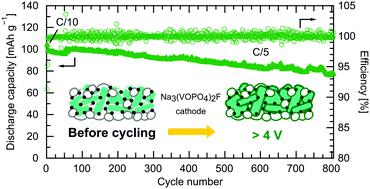当前位置:
X-MOL 学术
›
Energy Environ. Sci.
›
论文详情
Our official English website, www.x-mol.net, welcomes your
feedback! (Note: you will need to create a separate account there.)
4 V room-temperature all-solid-state sodium battery enabled by a passivating cathode/hydroborate solid electrolyte interface
Energy & Environmental Science ( IF 32.4 ) Pub Date : 2020-11-02 , DOI: 10.1039/d0ee01569e Ryo Asakura 1, 2, 3, 4, 5 , David Reber 1, 2, 3, 4, 5 , Léo Duchêne 1, 2, 3, 4, 5 , Seyedhosein Payandeh 1, 2, 3, 4, 5 , Arndt Remhof 1, 2, 3, 4, 5 , Hans Hagemann 5, 6, 7, 8 , Corsin Battaglia 1, 2, 3, 4, 5
Energy & Environmental Science ( IF 32.4 ) Pub Date : 2020-11-02 , DOI: 10.1039/d0ee01569e Ryo Asakura 1, 2, 3, 4, 5 , David Reber 1, 2, 3, 4, 5 , Léo Duchêne 1, 2, 3, 4, 5 , Seyedhosein Payandeh 1, 2, 3, 4, 5 , Arndt Remhof 1, 2, 3, 4, 5 , Hans Hagemann 5, 6, 7, 8 , Corsin Battaglia 1, 2, 3, 4, 5
Affiliation

|
Designing solid electrolytes for all-solid-state-batteries that can withstand the extreme electrochemical conditions in contact with an alkali metal anode and a high-voltage cathode is challenging, especially when the battery is cycled beyond 4 V. Here we demonstrate that a hydroborate solid electrolyte Na4(CB11H12)2(B12H12), built from two types of cage-like anions with different oxidative stability, can effectively passivate the interface to a 4 V-class cathode and prevent impedance growth during cycling. We show that [B12H12]2− anions decompose below 4.2 V vs. Na+/Na to form a passivating interphase layer, while [CB11H12]− anions remain intact, providing sufficient ionic conductivity across the layer. Our interface engineering strategy enables the first demonstration of a 4 V-class hydroborate-based all-solid-state battery combining a sodium metal anode and a cobalt-free Na3(VOPO4)2F cathode without any artificial protective coating. When cycled to 4.15 V vs. Na+/Na, the cells feature a discharge capacity of 104 mA h g−1 at C/10 and 99 mA h g−1 at C/5, and an excellent capacity and energy retention of 78% and 76%, respectively, after 800 cycles at C/5 at <0.2 MPa at room temperature. Increasing the pressure to 3.2 MPa enables a discharge capacity of 117 mA h g−1 at C/10 with a mass loading of 8.0 mg cm−2, corresponding to an areal capacity close to 1.0 mA h cm−2. The cell holds the highest average discharge cell voltage of 3.8 V and specific energy per cathode active material among all-solid-state sodium batteries reported so far, emphasizing the potential of hydroborates as electrolytes for a competitive all-solid-state battery technology.
中文翻译:

4 V室温全固态钠电池,通过钝化阴极/氢硼酸盐固体电解质界面实现
为全固态电池设计一种能够承受与碱金属阳极和高压阴极接触的极端电化学条件的固体电解质是一项艰巨的任务,尤其是当电池循环电压超过4 V时。在这里,我们证明了氢硼酸盐固体电解质Na 4(CB 11 H 12)2(B 12 H 12)由两种具有不同氧化稳定性的笼状阴离子构成,可有效钝化4 V级阴极的界面并防止循环过程中阻抗增长。我们显示[B 12 H 12 ] 2−阴离子在4.2 V以下相对于Na +分解/ Na形成钝化的中间相层,而[CB 11 H 12 ] -阴离子保持完整,在整个层上提供足够的离子导电性。我们的界面工程策略可以首次演示4 V级氢硼酸盐基全固态电池,该电池结合了钠金属阳极和无钴Na 3(VOPO 4)2 F阴极,而没有任何人工保护涂层。当循环到4.15 V对比的Na + /钠,细胞功能104毫安Hg的放电容量-1在C / 10和99毫安汞柱-1在室温下,当C / 5在<0.2 MPa下进行800次循环后,其在C / 5时的最佳容量和能量保持率分别为78%和76%。将压力增加至3.2MPa使得在C / 10下的放电容量为117mA hg -1,质量负荷为8.0mg cm -2,对应于接近1.0mA h cm -2的面积容量。到目前为止,该电池的平均放电电池电压最高,为3.8 V,每种阴极活性材料的比能量最高,这是全固态钠电池中的最高水平,强调了氢硼酸盐作为电解质在竞争性全固态电池技术中的潜力。
更新日期:2020-11-03
中文翻译:

4 V室温全固态钠电池,通过钝化阴极/氢硼酸盐固体电解质界面实现
为全固态电池设计一种能够承受与碱金属阳极和高压阴极接触的极端电化学条件的固体电解质是一项艰巨的任务,尤其是当电池循环电压超过4 V时。在这里,我们证明了氢硼酸盐固体电解质Na 4(CB 11 H 12)2(B 12 H 12)由两种具有不同氧化稳定性的笼状阴离子构成,可有效钝化4 V级阴极的界面并防止循环过程中阻抗增长。我们显示[B 12 H 12 ] 2−阴离子在4.2 V以下相对于Na +分解/ Na形成钝化的中间相层,而[CB 11 H 12 ] -阴离子保持完整,在整个层上提供足够的离子导电性。我们的界面工程策略可以首次演示4 V级氢硼酸盐基全固态电池,该电池结合了钠金属阳极和无钴Na 3(VOPO 4)2 F阴极,而没有任何人工保护涂层。当循环到4.15 V对比的Na + /钠,细胞功能104毫安Hg的放电容量-1在C / 10和99毫安汞柱-1在室温下,当C / 5在<0.2 MPa下进行800次循环后,其在C / 5时的最佳容量和能量保持率分别为78%和76%。将压力增加至3.2MPa使得在C / 10下的放电容量为117mA hg -1,质量负荷为8.0mg cm -2,对应于接近1.0mA h cm -2的面积容量。到目前为止,该电池的平均放电电池电压最高,为3.8 V,每种阴极活性材料的比能量最高,这是全固态钠电池中的最高水平,强调了氢硼酸盐作为电解质在竞争性全固态电池技术中的潜力。











































 京公网安备 11010802027423号
京公网安备 11010802027423号